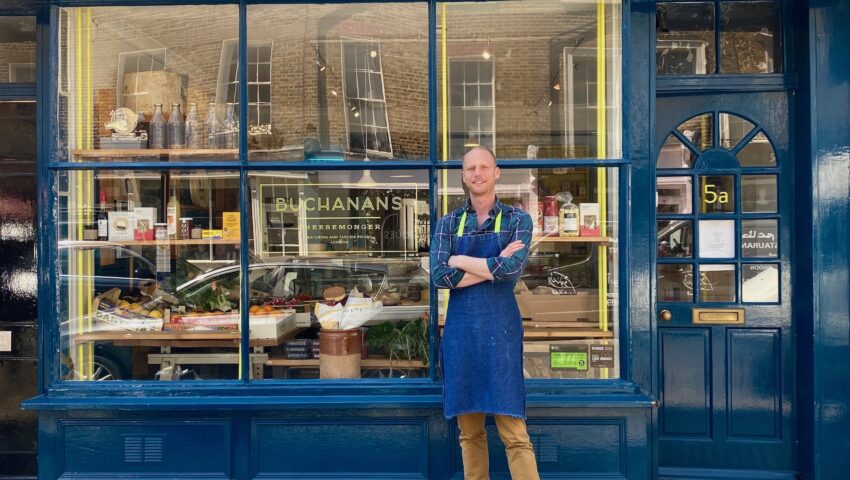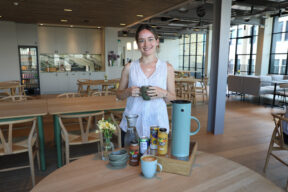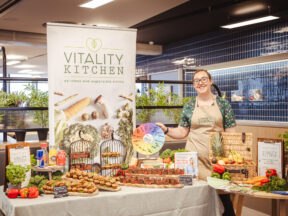Blogs
How many cheeses make the perfect cheeseboard

Buchanans Cheesemonger is an artisan cheesemonger based in Porchester Place, London. They have around 100 varieties of British and European cheese in their onsite maturing rooms. Rhuaridh, is the founder of this small team of food-lovers who have chosen cheese as their profession. Daryll recently took some time to talk to Rhuaridh about how he started working with cheese and shared some top tips.
How did you get into working with cheese?
I grew up in Aberdeen in a family obsessed with food and my mum used to treat me to different cheeses from the local deli, so cheese was always a favourite snack of mine as a child. I learned to cook in my teens and worked in a local hotel as pot-washer and prep chef before moving to front of house. After studying Industrial Design at university I returned to hospitality in a more serious manner, and in my role as restaurant manager at Martin Wishart, I was given responsibility of the cheese trolley. I guess you could almost say that the rest is history!
What happened next?
I got to know Iain and Karen Mellis who supplied the cheese to the restaurant and went to work with them in Edinburgh where they taught me the basics of ageing cheese in their maturing rooms. I then came down to London, in what was supposed to be a temporary move, before taking up a job at Per Se in New York. I was working at Paxton and Whitfield and ended up staying and doing a year’s traineeship, including a cheesemaking course and work placements with cheesemakers and with Marie-Anne Cantin, an esteemed affineur in Paris. I went on to become general manager of Paxton & Whitfield where I spent most of a decade running their London operations. I had always wanted to start my own business and in 2014 I combined my love of both cheese and hospitality by starting Buchanans Cheesemonger.
What do you love about being a cheesemonger?
I was (and still am) captivated by cheese as a product. It’s such a pleasing food that changes daily and you can have an effect on its outcome depending on how you treat it. Also, meeting the people involved in its production is always a joy and I love being a part of sharing their infectious passion.
How many cheeses do you think make the perfect cheeseboard?
I think it’s important to make sure you’ve got a good balance of different styles of cheese and different milks, so probably my perfect cheeseboard would have five: hard, soft, goat, washed, blue. But you can also achieve good balance with just three cheeses, with some of the styles overlapping, for example something hard, a soft washed-rind cheese, and a blue made with goat’s or sheep’s milk, for example. Generally, it’s better to have good-sized wedges of a few cheeses rather than lots of small pieces of many different cheeses, however tempting it might be to keep adding more.
What do you like to serve with cheese?
I like quite simple accompaniments that complement but don’t compete with the cheeses. A plain cracker and some seasonal fruit usually does the job.
Do you have a favourite cheese?
One cheese that I come back to time and again is Gorwydd Caerphilly from the Trethowan Brothers in Somerset. It has a delicious, lactic freshness and closer to the rind has a more mushroomy, savoury character. I taste a lot of cheese but it’s definitely the one I take home the most.
How can you tell when a cheese is ready to eat and how can you avoid buying a cheese that is over ripe?
It takes a lot of experience and skill for a cheese maturer to recognise when a cheese is going to be at its best. Soft cheeses change more rapidly over time than hard cheeses, and their window for perfection can be as short as a few days or a week. We spend a lot of time caring for our cheeses, looking at them and tasting them before deciding when they are ready. The best way to make sure you are buying cheese in excellent condition is to buy it from someone who knows what they are doing and can advise you well! But there are some things you can look out for – for example with soft, brie-like cheeses you don’t want there to be any ammonic aromas or a paste that is completely runny, as this might contribute to an unpleasantly strong flavour.
Do you have any other advice you would give someone buying cheese, especially a first timer?
If you can, go to a cheesemonger and ask for advice. Ask “what’s tasting good right now?”. We’re always happy to help those that are new to cheese and work out together what sort of thing they will like.
What’s the best way to store cheese?
We mature cheese at different temperatures and humidity levels, but once it is ready to eat, it’s best kept in the fridge. Cheese naturally evaporates moisture so porous papers like waxed or greaseproof are ideal as they allow the cheese to breathe. For short-term storage, cling film is fine but if left for longer the expelled moisture will be trapped on the surface, damaging the texture and flavour of the cheese. Whichever wrapping is used, cut it to size and make a tight seal on the exposed surfaces. Bring your cheese out of the fridge around an hour before serving to allow it to come up to room temperature.
Does the time of year change the flavour of the cheese?
Yes, it does. Most of our cheesemakers work with milk from a single source, often from their own herd, and lots use raw (unpasteurised) milk. Every day there will be differences in the weather, the grass and the herd, which make for unique flavours in each day’s milk. These are then evident in the different batches of cheese. This is something we celebrate and is the key difference between the cheese we work with and more industrially produced cheese where the goal is that every day’s production will taste the same.
Buchanans Cheesemonger
5a Porchester Place, London W2 2BS @buchananscheese buchananscheesemonger.com





